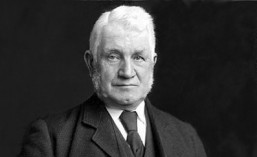Coming from a working class background Sir William Arrol was interested in the welfare of the working classes and supported policies to encourage trade, reduce taxation and encourage free education. He had been a supporter of the Liberal Party most of his life but by the time he entered a political career he had become a member of the Liberal Unionists.

Sir William Arrol by Sir (John) Benjamin Stone (platinum print, May 1897) © National Portrait Gallery, London
The Liberal Unionist Party was formed in 1886 by a faction of the Liberal Party who did not support William Gladstone’s bill for Irish Home Rule. They were concerned that introducing limited self-government in Ireland would eventually lead to independence for Ireland and the break-up of the United Kingdom. Although his politics were very much aligned with Liberal Party policies, on this one point Sir William Arrol felt very strongly that both Ireland and Scotland needed to remain united with England for economic survival. He first first stood as the Unionist Party candidate for South Ayrshire in the 1892 General Election, but was defeated. Gladstone’s Liberal Party came to power that year but the Liberal Unionists sided with the Conservative Party creating an overwhelming majority which defeated Gladstone’s Home Rule bill. In the following General Elections in 1895 and 1900, Sir William Arrol was successfully voted in as M.P. for South Ayrshire and the Liberal Unionists formed a coalition government with the Conservatives.
In his 10 years as Member of Parliament for South Ayrshire (1895 – 1905) Sir William Arrol was not the type of self-seeking politician giving long-winded speeches in the debating chamber. Neither was he a silent member and when he did address the House, the members would listen to him respecting him as a man and also the strong, reasoned arguments he put across. According to his friend and biographer, Sir Robert Purvis, Sir William Arrol’s strengths as a politician were behind the scenes in the numerous committees on which he sat, such as those for the Tube Railways; London Water Board; London Corporation; and the Cooper’s Hill Engineering College Enquiry.
He was as much committed to his political work as he had been to his engineering business and so in 1905 when members of the party were urgently summoned to the House of Commons on 8th March to vote on the important issue of Tariff Reform, Sir William Arrol responded with excessive devotion to duty. Having lost his first wife, Elizabeth, 2 years earlier, Sir William Arrol was to marry his cousin, Jessie Hodgart on 8th March. Following the wedding ceremony in Ayr, the couple immediately set off by train for London, arriving late in the evening, but in enough time for Sir William to go to Westminster and vote. The issue of whether or not to adopt a preferential tariff in favour of British colonies against foreign countries had caused divisions within the party. Sir William was in favour of the Tariff Reform but many were not. Despite their political differences, however, 353 members contributed to a subscription in recognition of his personal sacrifice in devotion to the party. With the money raised he was presented in the House of Commons on 11 April with a with a large silver cup engraved with the words
Presented to
Sir William Arrol M.P.
On his marriage, by his Unionist colleagues
in the House of Commons, in token of their
appreciation of his high sense of duty and
conspicuous loyalty, 1905
Following a spell of poor health Sir William retired from politics in 1906.
